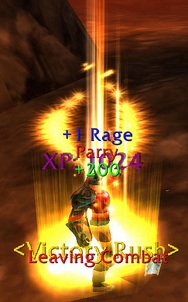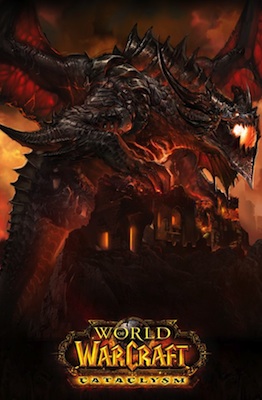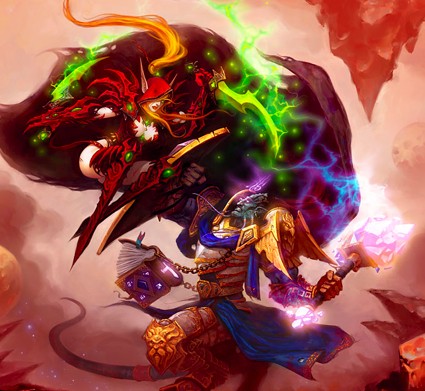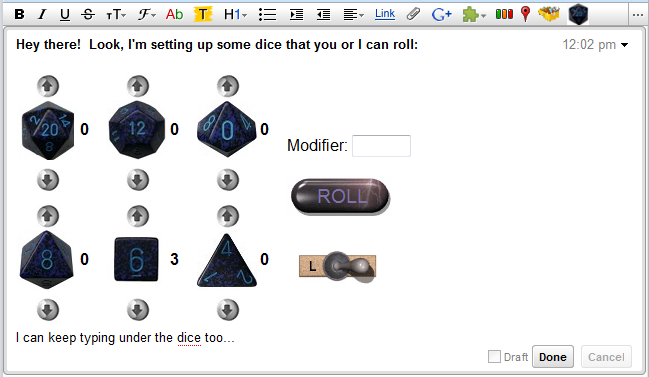or: How I Learned to Stop Worrying and Love the Ding
With World of Warcraft, Blizzard continued – and perhaps perfected – a game design they started to really shine at in Diablo 2: the art of always providing positive feedback and an ever-present goal just a few minutes away.
 When a player is playing World of Warcraft, they are constantly rewarded for victory. With every normal monster fight, there is a battle, a regular “rotation” of spells/abilities that the player uses to take out the normal monsters, and victory within 5-10 seconds. The monster gives an experience reward as long as the player isn’t max level, and a loot reward regardless. If the player is in the endgame, there’s a high likelihood that the experience reward has been swapped out for a reputation reward with whatever faction is tied to the monster, but the treadmill (if you’re being cynical about it) continues. Monsters are always available, so once you get your little thrill of victory after 5-10 seconds, you look around for the next monster, which takes about 3-5 seconds, and start again. And on, and on, and on. My lizard brain reward neurons are firing just writing about this stuff.
When a player is playing World of Warcraft, they are constantly rewarded for victory. With every normal monster fight, there is a battle, a regular “rotation” of spells/abilities that the player uses to take out the normal monsters, and victory within 5-10 seconds. The monster gives an experience reward as long as the player isn’t max level, and a loot reward regardless. If the player is in the endgame, there’s a high likelihood that the experience reward has been swapped out for a reputation reward with whatever faction is tied to the monster, but the treadmill (if you’re being cynical about it) continues. Monsters are always available, so once you get your little thrill of victory after 5-10 seconds, you look around for the next monster, which takes about 3-5 seconds, and start again. And on, and on, and on. My lizard brain reward neurons are firing just writing about this stuff.
Then, layered on top of the pure combat grind, there are the quests. One is almost never simply killing mobs in a vacuum of XP or rep grinding. Every monster killed is killed for a reason. Either you need to kill a certain number of them for a quest, or they sometimes (sometimes very rarely) drop an item you need for a quest, or they are in between you and the destination place or object you need for a quest. So not only are you getting the tiny reward for each monster beaten, you get closer and closer to a bigger reward of completing one (or often several tied to the same area of the map) quest. That quest, once completed, gives the same reward as a monster kill but in bigger doses: loot, XP, reputation. Quests are, by the way, the most extensive way that narrative is woven into WoW. It’s because WoW has thousands of quests that you don’t feel like you’re just doing the same thing over and over and over and over again.
Layered on top of questing is the reward of leveling either your character or your reputation with a faction. Aside from the occasional helpful loot reward from a monster or quest, this is the first reward you get that directly improves your character. With a new level you either get a new talent point to spend or a new spell. When you reach a new reputation level with a faction, you likely have access to new gear that will help your character.
 Finally, at the endgame you have layered on top of leveling/rep boosts for your character the concept of getting better gear for your dungeon/raid group. Players are rewarded by being part of a solid dungeon or raid group even if they are unlucky enough not to get any drops that help them directly by still getting drops that will help other members of the group, and so the group advances even when an individual character does not. Blizzard has improved this formula in later expansions by granting currency to each participating party member for every endgame boss killed that, once enough are accumulated, can be traded in for gear even if that character never gets a direct gear drop from any boss fights. For each raid, there is eventually a boss considered a “gear check.” That boss encounter is impossible for the raid to beat until they have gone through the earlier raid content enough times for their entire group to have good enough gear from the earlier bosses to have the raw stats high enough to beat the gear check boss. This boss is, therefore, the gateway to higher content.
Finally, at the endgame you have layered on top of leveling/rep boosts for your character the concept of getting better gear for your dungeon/raid group. Players are rewarded by being part of a solid dungeon or raid group even if they are unlucky enough not to get any drops that help them directly by still getting drops that will help other members of the group, and so the group advances even when an individual character does not. Blizzard has improved this formula in later expansions by granting currency to each participating party member for every endgame boss killed that, once enough are accumulated, can be traded in for gear even if that character never gets a direct gear drop from any boss fights. For each raid, there is eventually a boss considered a “gear check.” That boss encounter is impossible for the raid to beat until they have gone through the earlier raid content enough times for their entire group to have good enough gear from the earlier bosses to have the raw stats high enough to beat the gear check boss. This boss is, therefore, the gateway to higher content.
Like XP/quests before, some players are just raiding for better and better gear for their characters, others are raiding just to get to see all the content, and others are in it for both. But the raid activity for “progression” is the same for all three.
But wait, there’s more! That’s just one “stack” of reward layers. There are at least three other parallel reward paths:
Crafting: As players are out in the world-whether completing lowly quests or endgame raids-they will come across nodes of resources that can be harvested for crafting components. As players build gear from these components, their crafting skills are improved, and they get closer to building better and better gear. So players will often fight monsters just to get to a harvest node so they can get more resources to build more gear and raise their crafting.
Achievements: With Wrath of the Lich King, Blizzard added explicit achievements to the game. These can range from exploring all the points in any and all maps, to accumulating vanity pets, to completing all the quests in the game, to beating all the dungeons in heroic mode. As with the main reward system, achievements are often layered. For example, players get a small reward for exploring every node on one map, a bigger one for exploring every map on a continent, and the biggest one for fully exploring every map in the game.
 PvP: (Disclaimer: I never got deeply into PvP, so my knowledge of this dimension of the game is limited and may not be entirely correct.) Completely parallel to the main game, players may choose to participate in player versus player content. The PvP starts at level 10 (though you’ll be yelled at if you’re not level 19 to be the “appropriate” level for the 10-19 PvP group), and some players spend all their time “twinking” their level 19 PvP character. It ends at Arena matches, available only to characters who have gotten to max level, which have 2v2, 3v3, and 5v5 ladders. Arena PvP is associated with “seasons” in which the medium, higher, and highest ranking players are given gear roughly equivalent to the gear their characters would get at the endgame raid PvE content that is in the game for that season. As I said, I haven’t followed this aspect of the endgame very closely, but I’m pretty sure when new raid content is added to the game with the associated next level of raiding gear (your raid group will only have a fighting chance against higher end raid bosses if they’ve geared up from earlier raid bosses) a new Arena season starts at the same time with rewards on par with the new endgame gear.
PvP: (Disclaimer: I never got deeply into PvP, so my knowledge of this dimension of the game is limited and may not be entirely correct.) Completely parallel to the main game, players may choose to participate in player versus player content. The PvP starts at level 10 (though you’ll be yelled at if you’re not level 19 to be the “appropriate” level for the 10-19 PvP group), and some players spend all their time “twinking” their level 19 PvP character. It ends at Arena matches, available only to characters who have gotten to max level, which have 2v2, 3v3, and 5v5 ladders. Arena PvP is associated with “seasons” in which the medium, higher, and highest ranking players are given gear roughly equivalent to the gear their characters would get at the endgame raid PvE content that is in the game for that season. As I said, I haven’t followed this aspect of the endgame very closely, but I’m pretty sure when new raid content is added to the game with the associated next level of raiding gear (your raid group will only have a fighting chance against higher end raid bosses if they’ve geared up from earlier raid bosses) a new Arena season starts at the same time with rewards on par with the new endgame gear.
What say you, gentle reader? Did I miss anything?




